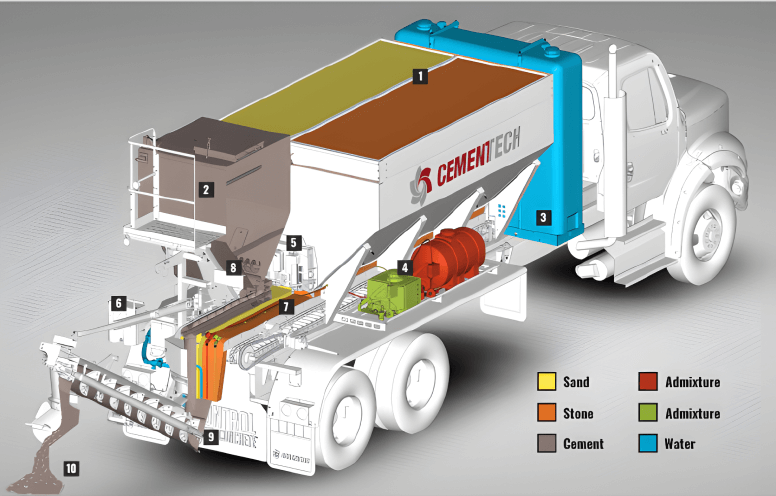Volumetric trucks are also known as mobile batching plants or volumetric concrete mixers. They are equipped with onboard systems to mix and produce concrete right on-site. This method allows for fresh concrete to be directly produced on the jobsite to improve time, reduce costs, and offer superior quality.
Only pay for exactly what you use.
Available in multiple mix design and color.
Always on time and on schedule.
On-Site Mixing for Flexible and Reliable Pours
Explore a Variety of Mix Designs and Colors
Save on Time and Money on Every Pour
Our cutting-edge volumetric mixer trucks are the heartbeat of our operations. These mobile batching plants, also known as volumetric concrete mixers, are equipped with on-board systems that allow us to mix and produce concrete directly at your jobsite.
In the early 1970’s, Cemen Tech realized the advantages volumetric mixing had over traditional concrete production methods. The drawing below illustrates how a volumetric mixer works.
Each concrete ingredient (sand, stone, cement, water, and admixture) is contained in a separate compartment. (1) Sand and stone are stored in open bins. (2) Cement is stored in a closed, watertight bin behind the aggregates. (3) Water is provided in an auxiliary tank. (4) Conveniently located admixture tanks are integrated into the system.
Once the storage bins are loaded, the operator will select the correct mix design for that pour. (5) The sand and stone gate will adjust to their correct position, and admixture and water flow rates are set.
(6) The operator hits the start button to begin operation. (7) As the sand and stone exit their respective bins, they pass under the “strike off” gates. The materials then pass under the cement bin into the mixing auger. (8) The cement bin precisely meters the correct amount of cement into the mix.

In the early 1970’s, Cemen Tech realized the advantages volumetric mixing had over traditional concrete production methods. The drawing below illustrates how a volumetric mixer works.
Each concrete ingredient (sand, stone, cement, water, and admixture) is contained in a separate compartment. (1) Sand and stone are stored in open bins. (2) Cement is stored in a closed, watertight bin behind the aggregates. (3) Water is provided in an auxiliary tank. (4) Conveniently located admixture tanks are integrated into the system.
Once the storage bins are loaded, the operator will select the correct mix design for that pour. (5) The sand and stone gate will adjust to their correct position, and admixture and water flow rates are set.
(6) The operator hits the start button to begin operation. (7) As the sand and stone exit their respective bins, they pass under the “strike off” gates. The materials then pass under the cement bin and falls into the mixing auger.(8) The cement bin precisely meters the correct amount of cement onto the mix. (2) Cement is stored in a closed, watertight bin behind the aggregates. (3) Water is provided in an auxiliary tank. (4) Conveniently located admixture tanks are integrated into the system.

Concrete Produced
If you have any questions, need a quote, or would like to explore how G3 Concrete can support your project, please call us or fill out the enquiry form.
Monday - Friday 8am to 5pm
24/7 On Request